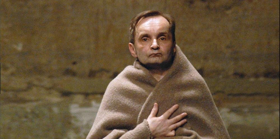Review: AVIGNON THEATRE FESTIVAL Presents 36, AVENUE GEORGES MANDEL By RAIMUND HOGHE

To enter or exit The Avignon Theatre Festival's stunning Cloître des Célestins one must cross in full view of bleacher seating on the space's Marley floor, which extends uninterrupted from the upstage gothic corridor. Despite such a conspicuous route, or perhaps because of it, many attending Raimund Hoghe's 36, Avenue Georges Mandel took a speedy or defiant mid-performance exit. The performance I attended this past Tuesday ended in a sturdy division between aggressive boos and a smattering of impassioned standing ovations. I am not sure if either extreme reaction was truly merited. I am even more uncertain as to why this piece, first performed in the Festival in 2007, was picked for a rare Avignon Theatre Festival revival.
The 69 year-old choreographer performer begins lying, back towards us in a gray blanket. Lights designed by Hoghe and Amaury Seval sculpt the space with washes of amber. Daily objects and black clothing are scattered around the space like totems. A man enters and encircles the items with a paintbrush and water. The voice we hear here, and indeed for the duration of the piece, is that of Maria Callas. 36, Avenue Georges Mandel was her Parisian address and this work is a ritualistic homage to the departed diva. Hoghe, a small statured man with a distinctive hunchback, walks with his mouth creased to a fine line and chin lifted in prima-donna contempt. His actions are purposefully minimalistic. Perhaps here less might indeed be less. His actions will later amass some complexities, though complex for this piece would include simultaneously walking and chewing gum. If his monastic self-seriousness was ever too much, escape is easily found in either Callas's voice or the ivy patched gothic cloister. Others, however, started to amble away.
Finally a rustle of recognition in the crowd as Callas's famous "Habanera" begins to be piped through the audio. Hoghe, now in high heels, lunges forward into a heroic pose. There is a hitherto unseen delight in this action, both on stage and in the audience. All the same Hoghe's affectlessness proves too much for the woman cattycorner to me. She falls into stifled laughter, which will oscillate until the end of the performance. Others have a different reaction. As Hoghe stands center stage a woman walks down the elevated center aisle, looks at him confidently, and exits the space. Later, while Hoghe is busying himself with a large black trench coat, a man exits with his wife, waving at the audience. This gets a grateful applause. Avignon is known for its passionate and expressive audiences. Though the two men to my right who almost got into a fist fight due to one of them having a conversation with his wife regarding an exit plan seemed a tad too far. In the face of all of this all out ferocity against his art, Hoghe was not deterred in his ritual. Self-satisfied as the work may be, he is admirably determined to find his satisfaction.
There are some images that are somewhat affecting. His moments of stillness next to the ivy touched medieval cloister are particularly stirring. Then, lying still back to us, he is joined on stage by Emmanuel Eggermont. Eggermont is young, tall, and striking. His shoulders move with ease down his back as he executes Hoghe's minimalist movement vocabulary. The cattycorner audience member's laughter ceases. That forced dignity, which had the air of burlesque with Hoghe, is received with nobility here. Whether this caused any introspection into her perception of differently abled people is uncertain. Eggermont is then displaced downstage left where he watches Hoghe. Hoghe then clears the space. He places each object fastidiously into two large paper bags. For much of the audience this additional framework was much too little, much too late.
The work is ultimately much more a showcase for Callas than it is for the stage action, and it was designed as such. 90 minutes of listening to Callas in a lovely French cloister is sufficient for an evening for me. The rest is simply gravy. However, Callas doesn't exactly share the marquis and the resounding disappointment of certain audience members was far from unwarranted. Hoghe in my view has executed an uneven yet curious choreographic study. Why it wasn't allowed to reside in the memory of 2007, and the space offered to either a more obvious triumph or, better still, a new artistic experiment remains the evening's most enduring mystery. I hope the Avignon premiere of his newest work, Canzone Per Ornella, will offer some answers.
Photo Credit: Rosa-Frank.com
Reader Reviews

Videos

